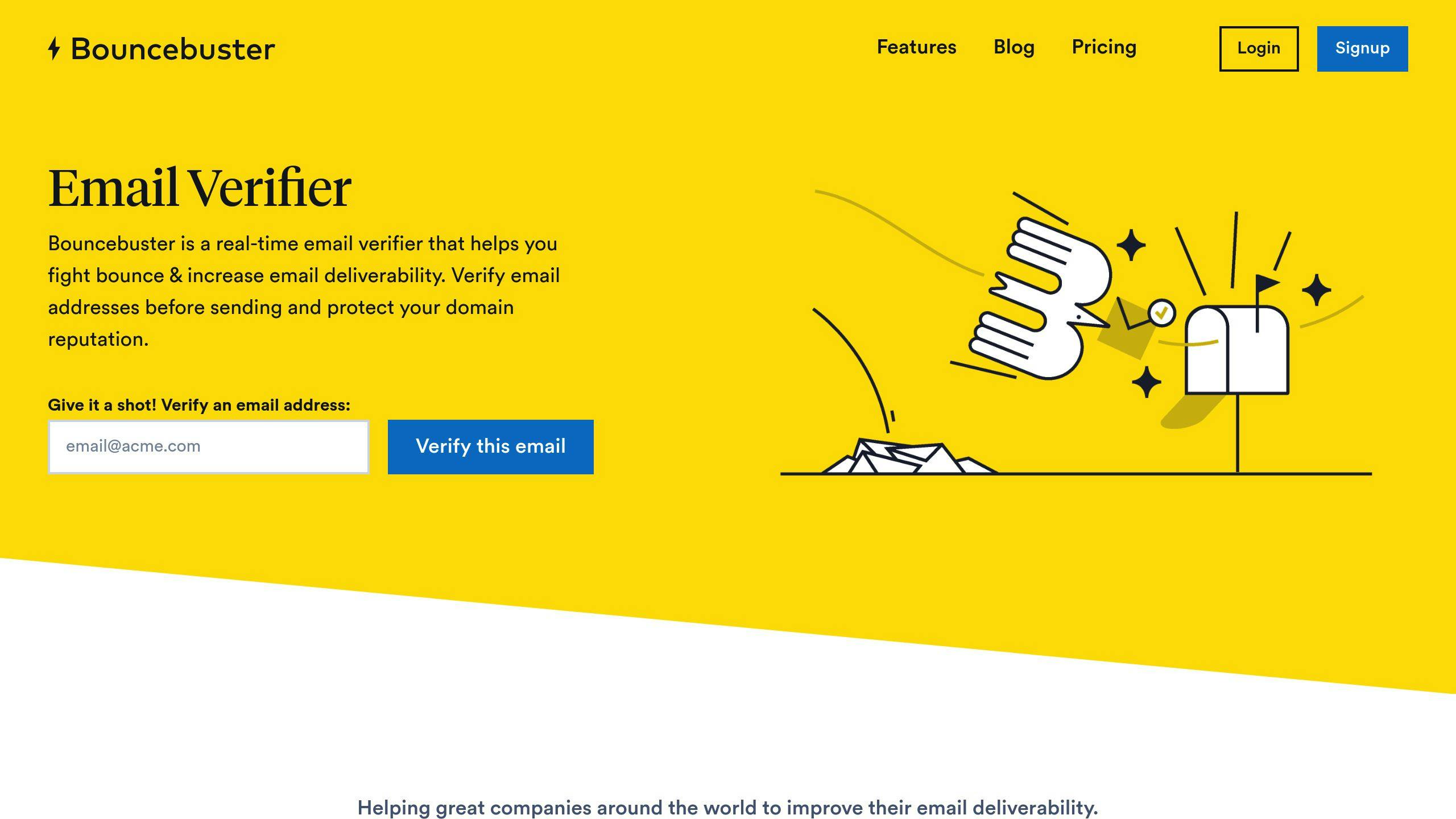Temporary email addresses are short-term email accounts designed for privacy and minimal use. They help protect your primary inbox from spam, marketing emails, and unwanted messages by offering a disposable email option that expires after a short period.
Why Use Temporary Emails?
- Account Verification: Receive confirmation codes while keeping your personal email private.
- Online Shopping: Access promotions without cluttering your inbox.
- Testing: Test email functionality in development.
- Forums: Join discussions anonymously.
Pros & Cons:
| Advantages | Disadvantages |
|---|---|
| Shields personal information | Limited recovery options |
| Prevents spam in the primary inbox | Not suitable for long-term use |
| Useful for testing and short-term tasks | Risk of losing access to critical data |
Businesses face challenges like higher bounce rates and skewed analytics from temporary emails. Tools like Bouncebuster can help detect and block them, ensuring better email list quality and sender reputation.
Key takeaway: Temporary emails are great for privacy and short-term use but unsuitable for important or long-term tasks like banking or healthcare.
How Temporary Email Addresses Function
How Temporary Emails Are Created and Expire
Temporary email addresses are set up by specialized platforms that generate unique inboxes. These inboxes come with automatic expiration, either based on time limits or the number of messages received.
Here’s how they work:
| Component | Purpose | Example |
|---|---|---|
| Address Generation | Creates unique email IDs | Random string + service domain |
| Inbox Management | Stores and displays messages | Temporary storage for emails |
| Expiration System | Sets a lifespan for the address | Deletes after time or usage |
While the basic idea is the same, services differ in how they operate and meet user needs.
Different Types of Temporary Email Services
The world of temporary email services includes a variety of options:
- One-Time Use Addresses: These are for single interactions, like signing up for a newsletter. Services such as 10 Minute Mail are a great example [1][6].
- Email Forwarding Services: These forward messages from a temporary address to a permanent one, acting as a middleman [4].
- Alias-Based Systems: Some email providers allow users to create aliases. These can be modified or deleted without affecting the primary email account, offering more flexibility [4].
- Private Relay Services: These advanced systems act as a privacy buffer. They receive emails, screen them, and then forward them to your main address. This approach minimizes spam and ensures better privacy compared to regular disposable emails [1].
Businesses dealing with temporary emails can use tools like Bouncebuster. These tools help identify and block temporary addresses, improving email deliverability and protecting domain reputation [4][6].
Pros and Cons of Temporary Email Addresses
Advantages and Disadvantages Comparison
Temporary email addresses are becoming more popular as people look for ways to protect their privacy online. With 85% of emails reported as spam in 2023, it’s no surprise that these tools are gaining traction [2].
| Category | Advantages | Disadvantages |
|---|---|---|
| Privacy & Security | • Shields personal information and reduces spam • Blocks data collection attempts • Keeps user identity private |
• Limited options for recovering accounts • Risky for important accounts due to potential security gaps • Loss of access to critical data if the email expires |
| Functionality | • Simplifies sign-ups for one-time use services • Keeps your primary inbox clutter-free • Allows creation of multiple aliases |
• Not suitable for ongoing communication • May face reliability issues • Fewer features compared to permanent email accounts |
| Business Impact | • Useful for testing and short-term projects • Handy for event-specific registrations • Avoids using personal emails for temporary needs |
• Can increase bounce rates • Skews marketing data • Negatively affects email sender reputation |
"Disposable emails may appear real but lack substance." [4]
Impact on Email Marketing and User Considerations
For businesses and marketers, temporary email addresses can cause challenges like:
- Higher bounce rates that disrupt campaigns
- Increased operational costs
- Inaccurate campaign analytics
- Difficulty in building lasting customer relationships [2][7]
To tackle these issues, tools like Bouncebuster help identify and manage temporary emails, improving deliverability and protecting domain reputation [7].
While temporary emails are a practical choice for privacy-conscious users, their value depends heavily on how they’re used. Businesses must weigh the benefits against the risks to maintain effective email strategies [1][4].
How to Use Temporary Email Addresses to Protect Your Privacy Online
sbb-itb-f42cab2
Impact on Businesses
Temporary email addresses may serve users well, but they can cause headaches for businesses, especially in email marketing and customer engagement. These disposable addresses disrupt the effectiveness of email communication, creating real challenges for companies.
Challenges for Email Marketers
Temporary email addresses in marketing databases lead to several problems that directly affect campaign success:
| Impact Area | Consequence | Business Effect |
|---|---|---|
| Deliverability & ROI | Increased bounce rates and wasted resources | Harmed sender reputation and less effective campaigns |
| Analytics | Distorted engagement metrics | Misleading performance data |
| Customer Relations | Lower engagement rates | Harder to build and nurture leads |
"Temporary email addresses are a major challenge for email marketers. They can lead to high bounce rates, reduced deliverability, and a damaged sender reputation." – Tom Sather, Senior Director of Research at Return Path [2]
How to Handle Temporary Emails
To minimize the issues caused by temporary email addresses, businesses can take a few smart steps:
- Use double opt-in verification to confirm legitimate email signups.
- Clean and validate email lists regularly to remove invalid addresses.
- Rethink signup incentives to encourage users to provide real email addresses.
These strategies help improve email deliverability and make campaigns more effective [7].
Tools Like Bouncebuster for Verification

A reliable way to combat temporary email issues is by using tools like Bouncebuster. This service offers a range of features, including bulk and manual email checks, API integration, and upcoming compatibility with marketing platforms. By using such tools, businesses can safeguard their domain reputation and enhance email performance.
Best Practices for Temporary Email Addresses
Responsible Use for Individuals
Temporary email addresses can be helpful for maintaining privacy, but it’s important to use them wisely. Here’s a quick breakdown of when they work well and when they don’t:
| Purpose | Good For | Not Recommended For |
|---|---|---|
| Testing Services | Signing up for newsletters, free trials | Banking, healthcare |
| Privacy Protection | Forums, downloads | Job applications |
| Spam Prevention | One-time promotions | Business communications |
For anything involving sensitive data or long-term services, stick to your permanent email address. It ensures better security and keeps your accounts consistent [3]. While temporary emails are convenient for individuals, they can create challenges for businesses.
Risk Mitigation Strategies for Businesses
Temporary email addresses can disrupt email marketing efforts. Businesses need to stay ahead with smart strategies to reduce their impact.
Email List Quality Control
Keep your email list in top shape with these methods:
- Regular Cleaning: Use email verification tools to spot and remove temporary email addresses [2].
- Smart Segmentation: Separate new subscribers into distinct groups and track their engagement to detect temporary email users early [4].
- Enhanced Verification: Add extra layers like real-time validation, double opt-in processes, and filters for temporary email domains.
Boosting Subscriber Engagement
Encourage subscribers to stick around by offering real value:
- Share exclusive, tailored content that gets better over time.
- Be transparent with privacy policies and explain how you handle data.
- Reward loyal subscribers with perks like discounts or special offers.
These steps not only reduce the impact of temporary emails but also build stronger relationships with your audience.
Conclusion: Key Points
Temporary email addresses provide a practical way for users to protect their privacy, but they can create hurdles for businesses, especially in email marketing and customer engagement. While these tools are useful for individuals, they can complicate efforts for businesses trying to maintain effective communication.
For users, temporary emails work well for one-time registrations but fall short for essential services like banking or healthcare. On the other hand, businesses must address the challenges these emails pose, which can interfere with marketing campaigns and require careful handling to minimize their impact.
To tackle the issues caused by temporary email addresses, businesses should prioritize strategies like maintaining high-quality email lists, boosting engagement, and safeguarding deliverability. Tools such as Bouncebuster can help identify and manage these emails, improving both deliverability and domain reputation.
Striking a balance between respecting user privacy and keeping communication channels efficient is crucial for the future of email marketing. Businesses can achieve this by focusing on:
- Regularly verifying email lists to ensure quality
- Offering personalized, exclusive content while being transparent about privacy policies
- Using real-time validation tools to maintain a strong sender reputation
- Segmenting email lists effectively for better campaign insights and performance analysis
FAQs
How long do temporary email addresses last?
The lifespan of temporary email addresses varies depending on the provider and type. Some may only last 10-30 minutes, while others can remain active for several days or even months [1] [2].
What impact do temporary emails have on email deliverability?
Using temporary email addresses can hurt email deliverability and sender reputation. When these addresses expire, emails sent to them bounce back, damaging your reputation and potentially triggering spam filters [4].
Are temporary email addresses safe to use?
Temporary email addresses can protect your privacy but come with risks. They might be used for harmful activities like phishing or identity theft [1]. Avoid using them for important tasks like banking, healthcare, or critical business communications. Instead, they work well for purposes like one-time site registrations, accessing downloadable content, testing services, or avoiding spam.
How can businesses protect themselves from temporary emails?
Businesses can use real-time email validation tools to identify and block temporary addresses. This helps maintain a clean subscriber list and improves email deliverability [4].
What are the different types of temporary email services?
Temporary email services typically fall into three categories [5]:
- Disposable emails: Fully throwaway addresses that expire quickly.
- Email aliases: Alternative addresses that forward to your main inbox.
- Forwarding services: Systems that route emails through temporary addresses.
Each option offers varying levels of privacy and convenience, depending on user needs.



